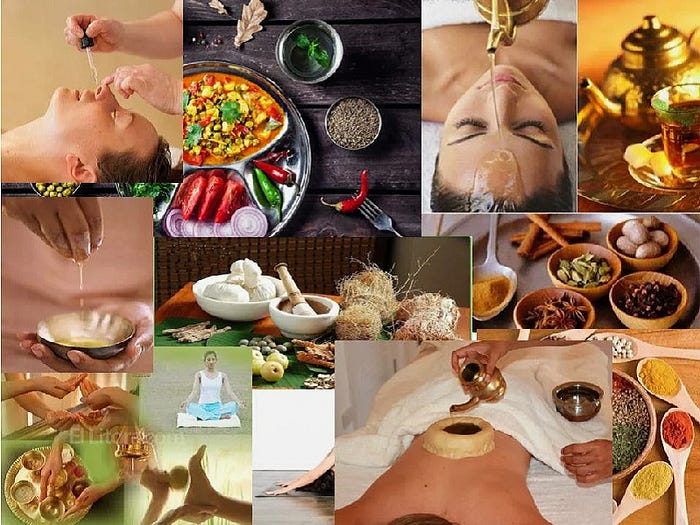What is Panchakarma
The five Therapeutic Treatments known as Panchakarma are given to the patient in order to fully detoxify the body. Before beginning any significant treatment, the body must be detoxified, according to Ayurveda. It is advised to get this treatment once every five years, even for healthy individuals, in order to cleanse the body of all the pollutants and chemical toxins that have accumulated over time. In many instances, Panchakarma by itself can treat a variety of chronic illnesses, negating the need for subsequent care.
What are the Benefits
Toxins are eliminated from the neurological system, lungs, bowels, blood vessels, and digestive tract by Panchakarma. It helps all glands secrete hormones and fortifies muscles and joints. It enhances sexuality, memory, focus, appetite, and sleep quality. After Panchakarma, it’s no surprise that many people feel as though their bodies have changed!
Who should follow this Program
People who are constantly stressed out and strained from their jobs and daily lives, people who are addicted to drugs, alcohol, or tobacco, people who have been taking prescription medications for a long time, people who have chronic digestive issues, rheumatism, arthritis, constipation, migraines, obesity, insomnia, or pretty much anyone who feels the need to cleanse their body.

How many days Should you stay
At least 21 to 28 days for a healthy, normal individual. The first day will be devoted to recuperation and doctor’s appointments. Depending on how well your body is responding, there may be one or two days off in between treatment stages. The therapy starts on the second day.
What is the Daily Program
Consultation with our Ayurvedic physician every day to track your growth and well-being
Sessions of Therapy
Herbal medicine used orally
Ayurvedic Diet (the doctor will decide this after consulting with you)
- Yoga and breathing exercises (one or two daily, if desired)
- Meditation (not required)
Anything else you want to do that doesn’t conflict with the therapy, like swimming in the river or going for a vigorous stroll in the forest that surrounds our campus.
The 5 Phases of Panchakarma
1. Purvakarma — the pre-purification preparation
The body must be prepared using recommended techniques to facilitate the release of toxins prior to the actual detoxification process starting. For this, two processes are employed: Swedana and Snehana
A full-body Massage using medicinal herbal oils is called snehana. To transfer the toxins to the gastrointestinal tract, the oil is rubbed into the body in a specific way. In order to relieve tension and support the nervous system, the oil also enters the skin, leaving the deep and surface tissues pliable and smooth. As said, snehana is administered for three to seven days.
Swedana means “sweating” or sudation. It is administered daily right after Snehana. Toxins can be further released from the body by adding a herbal mixture to the steam. Swedana dissolves the poisons and makes it easier for them to pass through the digestive system.
Pradhanakarma — The main purification process
2. Vamana — Vomiting Therapy
Therapeutic vomiting is the Ayurvedic Treatment for lung congestion that results in recurrent episodes of bronchitis, colds, coughing, or asthma. The Kapha that is producing the extra mucus is eliminated by this therapy.
3. Virechana — Purgation Therapy
Excess bile (Pitta) can cause rashes, skin irritation, acne, persistent fever, nausea, vomiting, and jaundice when it is released and builds up in the gall bladder, liver, and small intestine. Ayurveda advises using a therapeutic laxative or therapeutic purgation in these situations.
4. Nasya — Administration of Nasal Drops
Both the brain and one’s inner self can be accessed through the nose. When there is an excess of body humors accumulating in the sinuses, throat, nose, or head, medicinal drops administered via the nose are advised. The nose, the closest orifice, is used to get rid of them.
5. Basti — Enema Therapy
The colon is where Vata is most prevalent. Medicated oil formulations and herbal decoctions are administered into the rectum as part of basti treatment. Constipation, digestive issues, colds, sexual diseases, kidney stones, heart pain, backache, sciatica, and other joint difficulties are all alleviated by it. Basti can also be used to treat a wide range of other Vata conditions, including headaches, rheumatism, gout, arthritis, and muscle spasms.
The general Panchakarma Therapy for a healthy, typical person is the treatment plan described above. But before choosing the best course of action, our specialists will review your medical history and determine your current health state.
Courses / Treatments
Ayurveda and Yoga Retreats in Rishikesh
Ayurveda and Panchakarma Courses in Rishikesh
Ayurveda Treatment in Rishikesh
Panchakarma Treatment in Rishikesh
Ayurvedic Treatment Centre in Rishikesh
Ayurvedic Treatment Course in Rishikesh